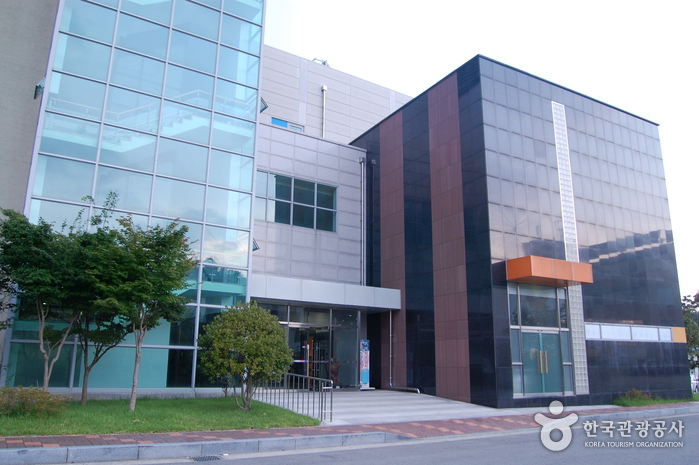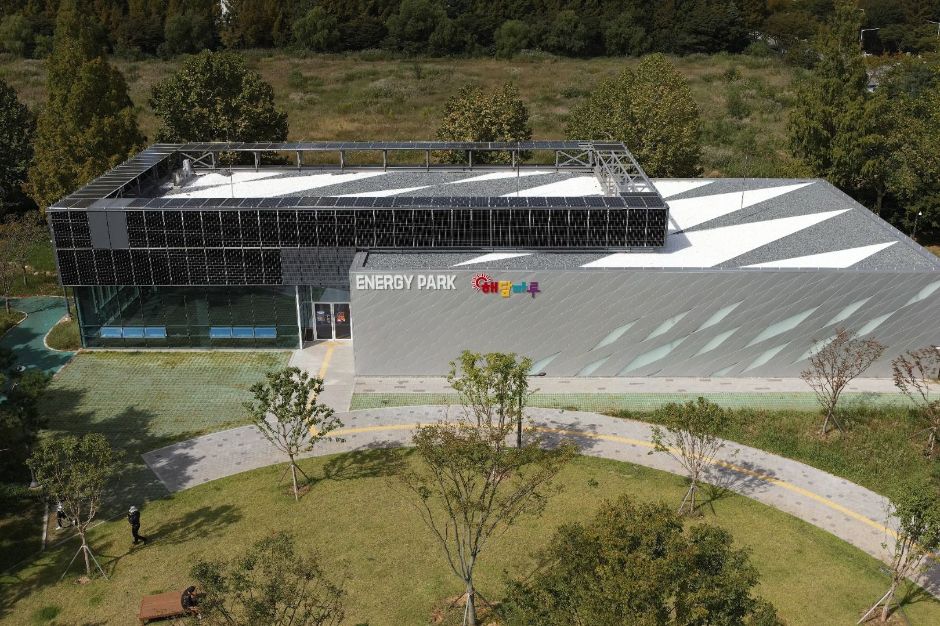Namdo Folk Food Exhibition Room & Honam Cultural Material Pavilion (남도향토음식박물관·호남문화자료전시관)
5.2Km 2021-11-27
477, Seoljuk-ro, Buk-gu, Gwangju
+82-62-410-6642
Located in Gwangju, the Namdo Folk Food Exhibition Room was established to preserve and promote the local foods of the Namdo region. The museum has a museum shop, both permanent exhibitions and special planned exhibitions, and a studio where visitors can watch a variety of video content related to the local foods. In the Honam Cultural Material Pavilion, literature, clothing, and artwork from the region are on display.
The museum building was designed to resemble both the long, rectangular presses used to make patterned rice cakes and the Ipseokdae Rock of Mudeungsan Mountain, a symbol of Gwangju. Even the colors of the building’s walls hold special significance. The obangsaek (five colors; blue, white, red, black, and yellow) symbolize the cardinal directions, the seasons, the major organs in the body, different tastes, feelings, and philosophy.
Hotel Central (센트럴관광호텔)
5.3Km 2025-01-07
68, Sangmuyeonha-ro, Seo-gu, Gwangju
+82-62-383-7575
Hotel Central is an affordable tourist hotel located in the city center of Gwangju. The hotel aims to meet every need of today's modern travelers, from high-speed internet to safety and comfort.
Therapy Spa_Sobe (테라피 스파 소베)
5.3Km 2025-10-23
33 Sangmuyeonha-ro, Seo-gu, Gwangju
+82-62-416-3000
Therapy Spa_Sobe gets its name by combining the first two letters of the the Latin words solus (health) and bellus (beauty) to create the word "Sobe".
The spa pursues natural health and beauty derived from nature. It is committed to constantly improving itself through research to offer precious and relaxing moments to those exhausted from the modern era. The programs available here include the SOBE Signature Rituals, Hormone Aging Signal, Energy Immune Boosting, Wedding Day & Beauty Contouring, and Vita Moms & Post-natal Touch. Enjoy specialized care through these programs.
Venture Business hotel [Korea Quality] / 벤처 비즈니스 호텔(유한회사 벤처) [한국관광 품질인증]
5.4Km 2024-07-08
5-6 , Sangmujungang-ro 38beon-gil, Seo-gu, Gwangju
+82-62-655-7777, +82-10-7274-5532
Venture Business Hotel stands close to Sangmu station on subway line 1 in Gwangju, Jeollanam-do. Visitors can chose from several types of room including ondol rooms, family rooms, VIP twin bed rooms with terrace, and accessible rooms with bathrooms for disabled customers. All rooms are equipped with air dressers to keep your clothing fresh, and some have massage chairs and jacuzzis. Hotel facilities include free breakfast, use of washing machine and dryer, a business center and a 24-hour information desk.
Korea Medical Institute Gwangju Branch ((재)한국의학연구소 광주분사무소)
5.4Km 2025-10-23
8F-10F, 58 Sangmujungang-ro, Seo-gu, Gwangju
Korea Medical Institute (KMI), a leader in 'K-health checkups,' operates health checkup centers across eight locations nationwide, from Seoul to Jeju. KMI has been striving to prevent and detect diseases early. It has led the popularization of comprehensive medical examinations in Korea. Based on 39 years of accumulated data and expertise, KMI has enhanced its capabilities in health checkups, services, and brand value.
By utilizing its diagnostic data accumulated over the years, KMI provides accurate test results and follow-up care promptly.
KMI will stay committed to becoming a lifetime health management partner and 'K-health checkup' leader by leveraging its excellence in Korean medicine, beyond health checkups for foreign patients.
Olive Young - Gwangju Catholic Peace Broadcasting Branch [Tax Refund Shop] (올리브영 광주평화방송)
5.6Km 2024-04-18
75, Sangmusimin-ro, Seo-gu, Gwangju
-
Uijae Museum of Korean Art (광주 의재미술관)
5.9Km 2024-11-14
155 Jeungsimsa-gil, Dong-gu, Gwangju
+82-62-222-3040
The Uijae Museum of Korean Art was established in memory of the famous Korean artist Heo Baekryeon. Construction of the museum ended in December, 1999, but the museum wasn’t officially opened until November 17, 2001. Built to mimic the curve of a gently sloping road, the museum’s unique design earned architect Jo Seongryong the 10th Korean Architecture Award the same year as the museum’s opening. Measuring 6,000㎡ (B1-2F) in size, the museum is comprised of two exhibition rooms, a storage facility, a seminar room, and a tea ceremony room for visitors. Since its opening, the Uijae Museum of Korean Art has hosted notable exhibitions and seminars such as the 2002 Biennale Project 2 International Symposium.
Energy Park Haedammaru (광주에너지파크 해담마루)
6.0Km 2024-12-17
131 Sangmugongwon-ro, Seo-gu, Gwangju
Energy Park Haedammaru opened in September 28, 2021, to educate visitors on the importance of energy. By exhibiting new and renewable energy, as well as different experience programs, visitors are able to understand the importance of energy usage and how to save more energy in daily life.
Gwangju Jeungsimsa Temple (증심사(광주))
6.1Km 2021-11-09
177, Jeungsimsa-gil, Dong-gu, Gwangju
+82-62-226-0108
Located on the western foothills of Mudeungsan Mountain, Jeungsimsa Temple is a representative temple of Gwangju. First founded by Buddhist monk Cheolgamseonsa Do Yun in 517 (Silla Kingdom), the temple was remodeled by Buddhist monk Hyesoguksa in 1094 (Goryeo dynasty) and again by Kim Bang in 1443 (Joseon dynasty). The temple was burned down during the Imjin War and was reconstructed in 1609 by three Buddhist monks: Seokgyeong, Sujang, and Dogwang. It underwent several additional restorations before being destroyed again by fire during the Korean War. Most of the existing buildings, including Daeungjeon Halll (main temple building), were rebuilt in the 1970s.
Chungjangsa Shrine (충장사)
6.2Km 2023-01-25
13, Songgang-ro, Buk-gu, Gwangju
+82-62-613-5407
When you reach Baejae along the tourist road leading up to Wonhyosa Temple, you can see the well-maintained tomb and the magnificent building of Chungjangsa Shrine on the left. It was built in 1975 as a memorial to General Kim Deok-ryeong, born in Mudeungsan Mountain. In the precincts, there are the shrine, where Kim Deok-ryeong's portrait and command paper are enshrined; the east room and west room; Eullyun Monument and Commentary Monument, the relics hall; Chungyongmun Gate; and Ikomun Gate. In the relics hall, the clothes of 'General Kim Deok-ryeong,' designated as Important Folk Material, and the coffin excavated from the general's tomb, as well as his handwriting, are on display. On the hill behind the shrine is Kim Deok-ryeong's tomb and tombstone, as well as his family's tomb.



![Venture Business hotel [Korea Quality] / 벤처 비즈니스 호텔(유한회사 벤처) [한국관광 품질인증]](http://tong.visitkorea.or.kr/cms/resource/97/2630397_image2_1.jpg)

![Olive Young - Gwangju Catholic Peace Broadcasting Branch [Tax Refund Shop] (올리브영 광주평화방송)](http://tong.visitkorea.or.kr/cms/resource/21/2886921_image2_1.jpg)



 English
English
 한국어
한국어 日本語
日本語 中文(简体)
中文(简体) Deutsch
Deutsch Français
Français Español
Español Русский
Русский